How Long Do You Keep Newborn Insert in Car Seat
(Last Updated On: January 4, 2021)
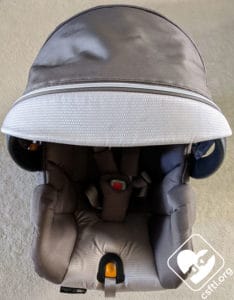
Chicco KeyFit 30
As a team of Child Passenger Safety Technicians and global safety advocates, we have seen many car seats come and go over time. While we love exploring new additions to the market, and applaud new innovation, we do enjoy reflecting on existing car seats that remain consistent, easy-to-use options in an ever-changing market.
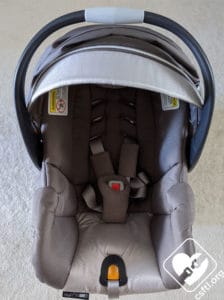
Chicco KeyFit
Chicco is one manufacturer that we've watched grow over the years. Their line of car seats has expanded to include something for children of all ages – rear facing only, convertible (NextFit), multimode (Fit4), and combination (MyFit) car seats, plus some well-fitting, crowd pleasing belt positioning booster seats (KidFit, GoFit). Despite this expansion in their product line, one car seat that was designed for the tiny passengers has remained in the spotlight – the Chicco KeyFit 30. Join us for an updated look at this classic rear facing only car seat.
CSFTL Quick Stats
- Weight range: 4-30 pounds
- Height range: less than 30 inches AND at least 1 inch of shell above the child's head
- Handle position, United States: any locked position may be used in the vehicle
- Handle position, Canada: handle must be in the locked "carry" position in the vehicle
- Inflatable seat belts: not permitted
- Expiration: 6 years
- Chicco requires replacement after any crash
Measurements
- Crotch buckle positions: 4 inches
- Lowest harness position: 6 inches (with insert)
- Width at widest point (carrier handles): 17.5 inches
- Seat weight (carrier): 9.4 pounds
- Base weight: 7 pounds
Features
Infant Inserts
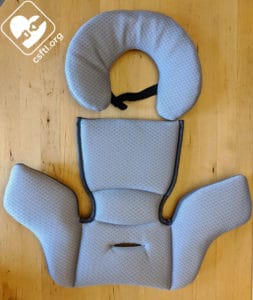
Chicco KeyFit infant inserts
The Chicco KeyFit 30 has a two piece infant insert that includes a newborn positioner and a head insert. The newborn positioner – the part the child sits on – is optional for 4-11 pounds but must be removed no later than when the child weighs 11 pounds.
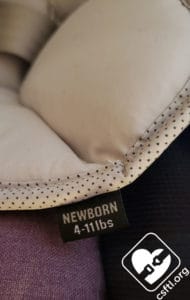
Chicco KeyFit infant insert
The head insert is optional at any weight as long as the harness is in one of the lower two sets of harness slots. Since the head insert requires threading through the slots above the harness, it can not be used if the harness is in the top set of slots.
Note: these inserts vary slightly between the trim levels.
Recline Foot
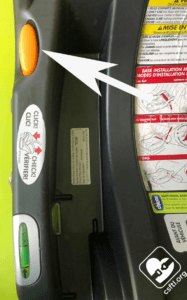
Chicco KeyFit recline foot adjuster
The KeyFit's recline foot is quite easy to extend and retract. When I'm teaching my car seat class, it amuses me to hold the base up, squeeze the yellow buttons and watch the parents' faces as the recline foot extends.
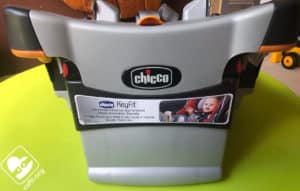
Chicco KeyFit recline foot extended
In most cases, this recline foot can be large enough to make the KeyFit fit in a wide variety of vehicles.
Recline Angle Indicator

Chicco KeyFit recline angle indicator
The base of the seat has a bubble style recline angle indicator with two arrows marking the allowed recline range. We've found this indicator quite easy to use.
Recline Angle Indicator: Baseless Mode
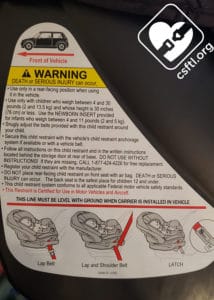
Chicco KeyFit basless recline angle indicator and FAA approval
The KeyFit can also be installed without the base. We'll discuss more of the hows and whys around this type of installation later but wanted to mention here that the recline angle indicator for baseless mode is a label with a red line on the side of the carrier itself. This line must be level to the ground when the seat is installed without the base.
Note About the Recline Angle Indicator
- The closer to the back of the vehicle seat that the bubble is, the more reclined the seat will be.
- The closer to the front vehicle seat the bubble is, the more upright the seat will be.
While the bubble can technically be anywhere between the two lines for a correct installation, it's important to note: that small babies and infants those without head control would likely benefit from having the seat as reclined as allowed to help with positioning and proper airway support.
Lockoff
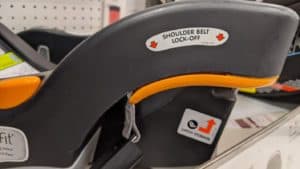
Chicco KeyFit lockoff
When installing a car seat with the vehicle seat belt, the belt must be locked in some way, either by vehicle seat belt's locking mechanism or with a lockoff device that's part of the car seat itself. The KeyFit's lockoff remains among the easiest to use, it's just a clearly marked spot on the base where the seat belt slides in. It's so easy to use that caregivers tend to expect the lockoff on their child's convertible car seat to be as easy as one on the KeyFit! (Spoiler: that's not usually the case.)
Premium Lower Anchor Connectors
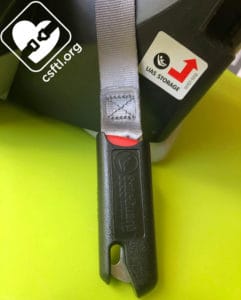
Chicco KeyFit lower anchor connectors
The Chicco KeyFit 30 includes premium lower anchor connectors that make installation just a little bit easier by simply pushing on to the vehicle's lower anchor bar. These lower anchor connectors have convenient, clearly marked storage spots located on either side of the base where they should be placed while not in use.
Handle Position

Chicco KeyFit 30 handle adjuster
The KeyFit 30's handle can be in any locked position while the seat is in the vehicle. The handle adjusts quite easily by pushing the two orange buttons on either side of the handle at the same time. We found that the handle didn't catch on the canopy the way some other rear facing only car seats do.
In the United States, the handle can be in any locked position. In Canada, the handle must be in the locked "carry" position in the vehicle.
Installation
With the Base, Using Lower Anchors
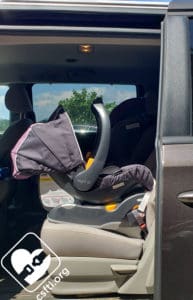
Chicco KeyFit installed with lower anchors
To install the base with lower anchors start by removing each lower anchor connector from the storage spots on either side of the base. Place the base on the vehicle seat with the lower anchors towards back of the vehicle seat and adjust the recline foot as needed to achieve the proper recline angle.
Connect the lower anchor connectors to the lower anchors in the vehicle seat bight. The larger portion of the connectors will be on top, they will click into place when they're securely attached.
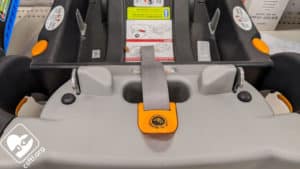
Chicco KeyFit lower anchor release
To tighten the lower anchors, apply firm pressure with one hand to compress the base into the vehicle seat while pulling the lower anchor webbing on the top of the base with your other hand. Finally, confirm that the recline bubble is still in the allowed range and that the base moves less than one inch at the belt path.
Note: a rolled towel to help with the recline angle is not permitted when installing this seat with the base. Other note: the recline angle adjuster on the seat is often sufficient to install the base at the correct angle.
With the Base, Using the Vehicle Seat Belt
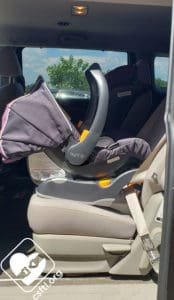
Chicco KeyFit installed with the vehicle seat belt
The Chicco KeyFit 30 base includes two yellow lockoffs – one on each side of the base. When installing the base with the vehicle seat belt, the lap portion of the belt should be as snug as possible. To do this, thread the vehicle seat belt through the clearly marked belt path, then buckle the seat belt. Press down on the base while removing the slack from the vehicle seat belt by pulling straight up. Sometimes, adding a little pressure with a knee, pushing the base back into the vehicle seat back helps with removing the slack.
Once the slack is removed from the lap portion of the seat belt, continue to keep the pressure on the base and hold the seat belt in place to retain that snug seat belt. Then, slide the shoulder portion of the vehicle seat belt through the lockff on the opposite side of the base from the side where the seat belt is buckled. The most common error we see is caregivers diligently working to use both lockoffs at once. We commend their efforts but remind our readers that only the one lockoff, on the opposite side of the buckle, should be used.

Chicco KeyFit lockoff
The lockoff will then hold the vehicle seat belt tight and keep the installation secure. In most cases, we've found that the KeyFit's lockoff helps to make vehicle seat belt installations a breeze!
Installation Without the Base

Chicco KeyFit installed without the base
The final way to install the Chicco KeyFit 30 is without the base. This method is particularly beneficial when traveling!
To install the KeyFit 30 without the base, place the carrier portion on the seat with the foot end facing the rear of the vehicle. Locate the red recline angle line on the side of the carrier, and adjust the carrier until the line is parallel with the ground.
Next, thread the lap portion of the vehicle seat belt through the belt guides on each side of the carrier and buckle the belt. Lock the vehicle seat belt using the appropriate method for your vehicle and apply firm pressure to the middle of the seat while removing the slack from the vehicle seat belt. Finally, confirm that the recline line is still parallel with the ground and the seat moves less than one inch at the belt path.
Note: a rolled towel can be tucked into the portion of the carrier underneath the child's feet to help with the recline angle is permitted when installing this seat without the base.
Fit to Child
Newborn Doll
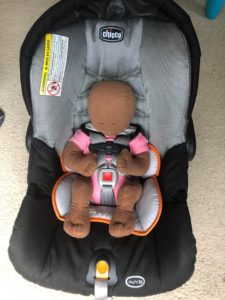
Chicco KeyFit newborn doll
Our Huggable Images newborn doll weighs 7 pounds and is 17 inches long. The doll fits in the KeyFit 30 very well with the infant insert in and the optional head insert removed.
Newborn
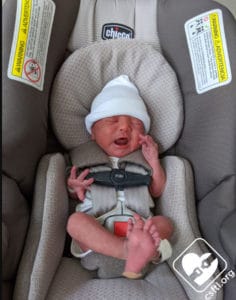
Chicco KeyFit 30 newborn
This model couldn't have been more pleased to be heading home in the Chicco KeyFit! We can see how well the seat fits this 4 day old, 6 pound, 20 inch long model.
Newborn

Chicco KeyFit newborn
Our newborn human is merely 18 days old weighs 8 pounds, and is 20 inches long. With the lower body insert and head padding in place, the seat fit this kiddo very well from the start!
1 Month Old
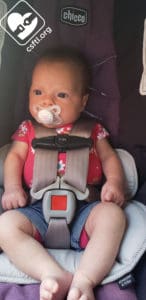
Chicco KeyFit 1 month old
This adorable model is 1 month old. She weighs 9 pounds, 2 ounces and is 21 inches long. She is still fitting very well in the seat using the lowest set of harness slots and the body insert. When she weighs 11 pounds, that lower insert will have to be removed.
6 Months Old
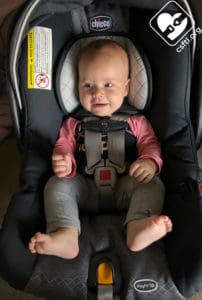
Chicco KeyFit 6 months old
Our 6 month old model weighs 15 pounds, 8 ounces, and is almost 26 inches long. The seat fits her well and she's got a bit of growing room left.
18 Months Old
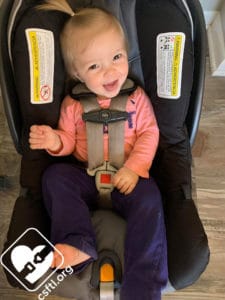
Chicco KeyFit 18 months old
This delightful 18 month old kiddo is on the tiny side at 21 pounds and 30 inches tall. But here she is, fitting into the KeyFit 30! She's at the very top of the height limit but she does fit in the seat. That's a rare thing for a rear facing only car seat.
Important Information: Where to Find
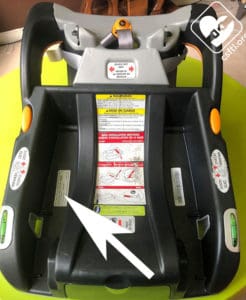
Chicco KeyFit date of manufacture label
Date of Manufacture label: the seat expires after 6 years. There's a label on the bottom of the base and on the bottom of carrier itself. These labels include the expiration date as well as the date of manufacture.

Chicco KeyFit FAA approval label
FAA Approval, United States: the Chicco KeyFit 30 is FAA approved for use aboard aircraft. This information, typed in red letters, can be found on the side of the carrier portion of the seat – near the red recline line.
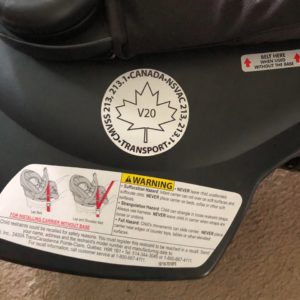
Chicco KeyFit Canada NSM label
FAA Approval, Canada: the Chicco KeyFit 30 is FAA approved for use aboard aircraft in Canada as well.
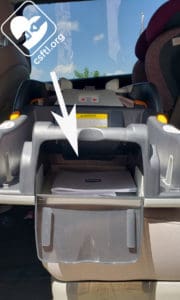
Chicco KeyFit manual storage
Manual Storage: the owner's manual for the KeyFit 30 stores nicely in a small compartment located on the front of the base. This compartment is also helpful for tiny items that need to travel with you. Note: the door often sticks a bit at first but does loosen up over time.
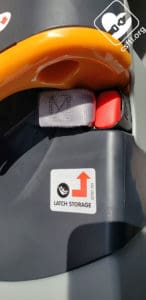
Chicco KeyFit lower anchor storage
Lower Anchor Storage: each lower anchor connector has its own small storage compartment located on either side of the base.

Chicco KeyFit UAS storage
In Canada, the UAS storage is in the same location. It's labelled UAS storage on one side of the seat and in French on the other side.
Overall Thoughts
The Chicco KeyFit 30 has been, and remains, a solid rear facing only choice. We've found that it works well in a wide variety of situations. It's easy to install and use correctly — the true benchmark of an excellent car seat. The low harness slots and optional inserts allow this seat to fit small babies well, while also providing plenty of room to grow! We've been a fan of this seat from our earliest days as an organization, that opinion has stood the test of time over the course of countless online and in-person car seat checks.
How Long Do You Keep Newborn Insert in Car Seat
Source: https://csftl.org/chicco-keyfit-30-review/